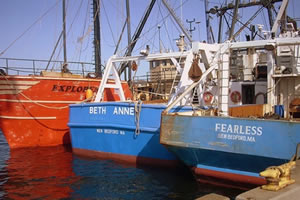Can Offshore Wind Power Revive U.S. Ports?
 Benjamin Storrow for Scientific American: This salt-caked fishing port has been flush with wind prospectors ever since Massachusetts legislators passed a law for massive wind development in the shallow waters south of Martha's Vineyard.
Benjamin Storrow for Scientific American: This salt-caked fishing port has been flush with wind prospectors ever since Massachusetts legislators passed a law for massive wind development in the shallow waters south of Martha's Vineyard.
Ed Anthes-Washburn, a local port official, estimates he gives five harbor tours a month to wind industry representatives. Planning for the industry's arrival now occupies much of his time, alongside proposals to redevelop several old industrial sites and a Seattle-style fish pier.
“It started Aug. 8, the day the governor signed the bill,” Anthes-Washburn said, gazing out over the harbor here, where a mass of fishing trawlers, scallopers and clam boats formed a rocking forest of rigging and nets. “It's been pretty consistent since then.”
States up and down the Atlantic coast are rushing to become the capital of America's burgeoning offshore wind industry, hoping the massive turbines will breathe new life into ports mired by a shrinking fishing industry and a flagging industrial base.
Maryland officials last month approved renewable energy credits for two developments totaling 368 megawatts off their shores in a bid to transform Baltimore and Ocean City into the industry's manufacturing and maintenance hub in the Mid-Atlantic (Climatewire, May 12).
Lawmakers in New Jersey are counting down the days until Gov. Chris Christie (R) leaves office early next year, when they plan to restore their own credits for offshore wind developments (Energywire, June 9). Full Article:
Comments (0)
This post does not have any comments. Be the first to leave a comment below.
